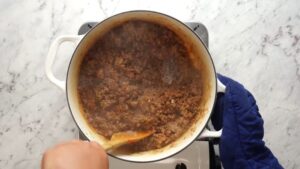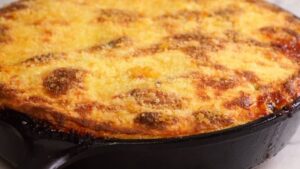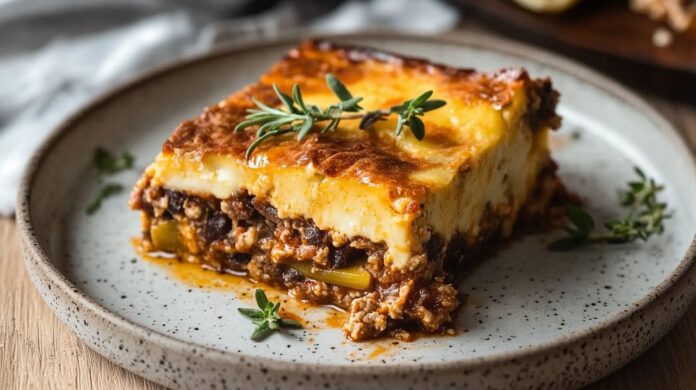
Moussaka is a classic Greek dish made with layers of roasted eggplant, spiced ground meat, and creamy béchamel sauce. It’s baked until golden and bubbling, and it’s the kind of meal that feels cozy, hearty, and totally satisfying.
This traditional recipe is a great way to enjoy real Greek food at home. The flavors are rich but simple, and everything comes together in a way that just works.
It’s perfect for dinner when you want something filling and homemade. Serve it with a side salad or some crusty bread, and you’re all set.
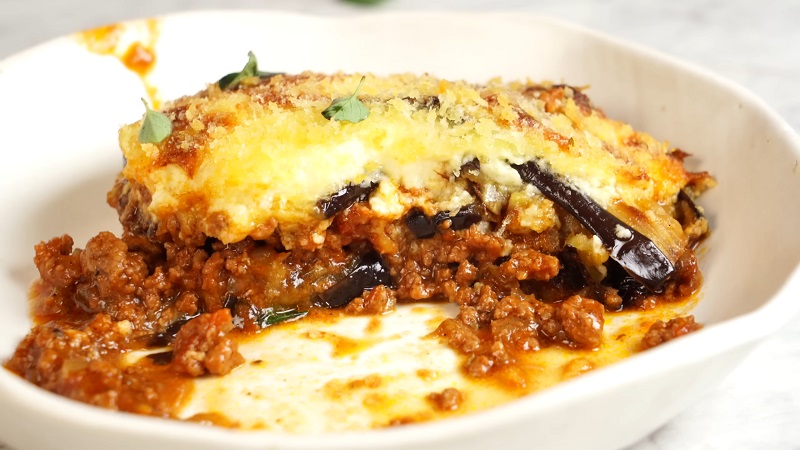
Classic Greek-Style Moussaka Recipe
Equipment
- Large frying pan
- Saucepan
- Baking dish (9x13 inch or similar)
- Sharp knife
- Cutting Board
- Whisk
- Mixing bowls
- Oven
Ingredients
For the Eggplant Layer
- 2 large eggplants about 800g, sliced into 1 cm thick rounds
- 2 tbsp olive oil
- Salt to taste
For the Meat Sauce
- 1 tbsp olive oil
- 1 onion finely chopped
- 2 garlic cloves minced
- 500 g ground beef or lamb
- 1 can 400g crushed tomatoes
- 2 tbsp tomato paste
- 1/2 tsp ground cinnamon
- 1/2 tsp dried oregano
- Salt and pepper to taste
For the Béchamel Sauce
- 4 tbsp butter
- 4 tbsp all-purpose flour
- 2 ½ cups 600ml whole milk
- 1/4 tsp ground nutmeg
- Salt and pepper to taste
- 1/2 cup grated Parmesan cheese
- 1 egg lightly beaten
For Topping
- Extra grated Parmesan or breadcrumbs optional
Instructions
- Preheat Oven & Prep EggplantsPreheat your oven to 200°C (390°F). Line a baking tray with parchment. Brush both sides of the eggplant slices with olive oil and sprinkle with salt. Lay them out in a single layer and roast for 20–25 minutes, flipping halfway, until soft and slightly golden. Set aside.
- Make the Meat SauceIn a large frying pan, heat olive oil over medium heat. Add the chopped onion and cook until soft, about 5 minutes. Add garlic and cook for 1 more minute. Stir in the ground meat and cook until browned. Add crushed tomatoes, tomato paste, cinnamon, oregano, salt, and pepper. Let it simmer on low heat for 15–20 minutes, until thickened.
- Make the Béchamel SauceIn a saucepan, melt butter over medium heat. Stir in flour and whisk constantly for about 1 minute. Slowly add the milk, whisking to avoid lumps. Cook until the sauce thickens (about 5 minutes). Season with nutmeg, salt, and pepper. Remove from heat, stir in the Parmesan, then whisk in the beaten egg quickly (so it doesn’t scramble).
- Assemble the MoussakaIn a greased baking dish, layer half the eggplant slices. Spread all of the meat sauce over them. Add the remaining eggplant slices on top. Pour the béchamel sauce evenly over everything and spread it out with a spoon. Sprinkle extra Parmesan or breadcrumbs on top if you like.
- BakeBake at 180°C (350°F) for 45 minutes, or until the top is golden brown and bubbling. Let it rest for 15 minutes before serving to help it set.
Video
Notes
- Salt the Eggplants: For less bitterness, salt the eggplant slices beforehand and pat them dry after 15 minutes.
- Meat Sauce Magic: The longer the meat sauce simmers, the deeper the flavor.
- Layer Variations: Try swapping in zucchini or potatoes for a twist.
- Creamy Upgrade: Add a splash of cream to the béchamel for extra richness.
How to Avoid a Watery Moussaka
No one wants to cut into their Moussaka only to find a puddle at the bottom of the dish. If yours ends up soggy or falls apart on the plate, here’s what’s probably going wrong — and how to fix it.
1. Roast the Eggplant — Don’t Fry It, and Don’t Skip It
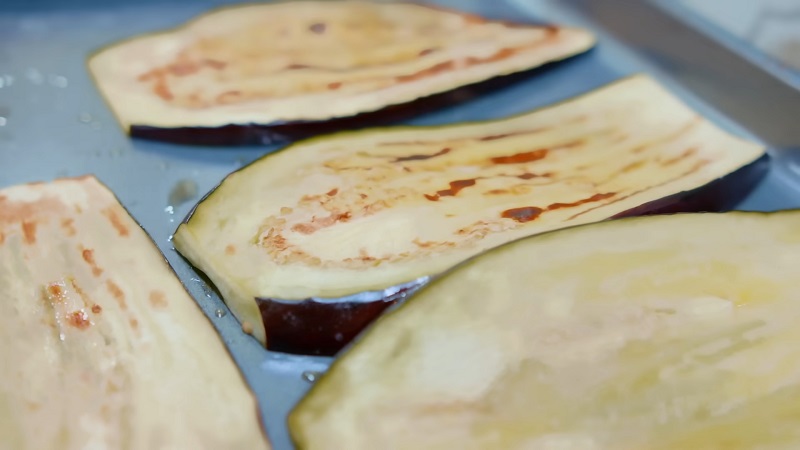
Eggplant is like a sponge. If you don’t cook the moisture out of it first, it will release that water into your moussaka while it bakes.
Roast it in the oven until soft and slightly golden. Don’t stack the slices or overcrowd the tray.
2. Let Your Meat Sauce Reduce Properly
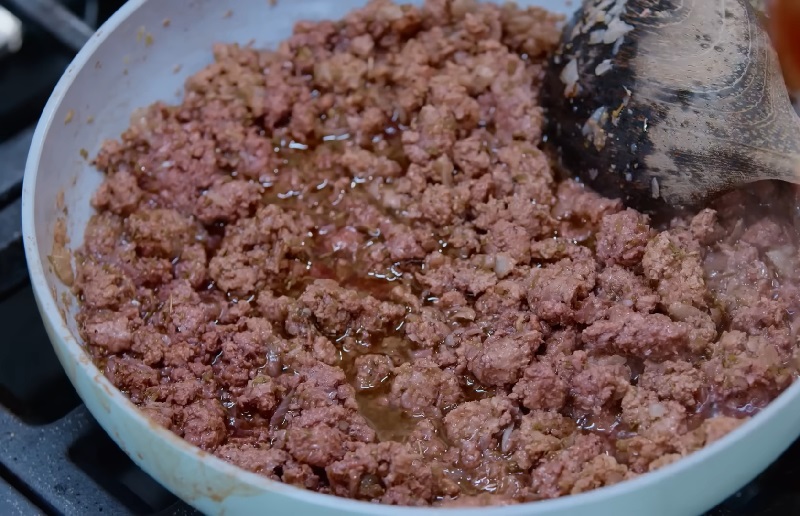
This is a huge one. You want your meat mixture thick, not saucy. Simmer it uncovered long enough to let most of the moisture cook off. It should look almost dry when you spoon it into the dish.
3. Your Béchamel Sauce Matters
If your béchamel is too thin going in, it’ll stay loose and won’t hold shape. Make sure it’s thick enough to coat the back of a spoon before you pour it over the top. A good béchamel should sit, not sink.
4. Let It Rest Before Serving
Once it’s out of the oven, hands off for at least 15–20 minutes. Moussaka firms up as it cools slightly — if you slice into it right away, it will collapse and release steam (which = water).
Flavors That Actually Pair Well with Moussaka (And a Few That Don’t)
Moussaka is rich, hearty, and full of bold spices like cinnamon, garlic, and tomato — so what you serve with it really matters.
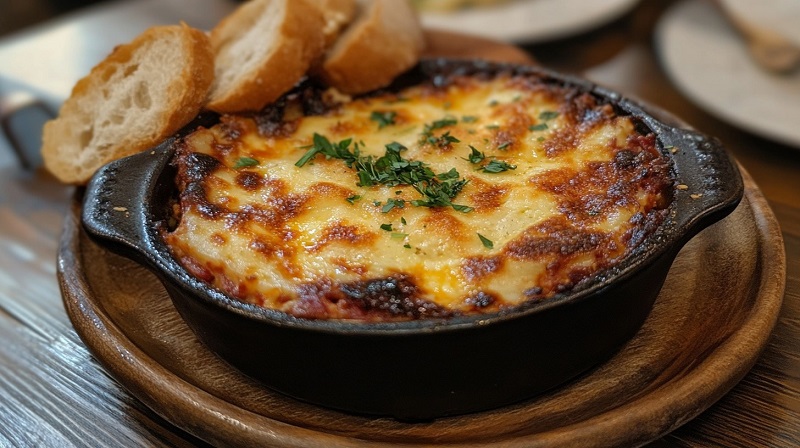
Let’s keep it simple: here’s what complements the dish and what clashes with it.
✅ Flavors That Work
- Lemon & Herbs – Think Greek lemon potatoes, herby salads with dill or mint, or a splash of lemon juice over roasted veggies. That bright acid cuts through the richness perfectly.
- Garlic & Yogurt – Tzatziki is a no-brainer. The cold, tangy, garlicky dip is exactly what Moussaka needs to feel balanced.
- Simple Greens – A fresh salad with cucumber, tomato, and olive oil works beautifully. Even steamed greens like spinach or chard with olive oil and a bit of vinegar hit the right notes.
- Bread – Crusty bread to mop up the sauce? Always yes. Keep it plain though — no garlic bread or flavored loaves.
🚫 Flavors That Clash
- Heavy pasta sides – Don’t double down on starch. Skip the pasta salads, mac and cheese, or anything creamy. Moussaka already brings the richness.
- Sweet sides – Caramelized anything or sweet dressings throw the balance off. Let Moussaka be the star and keep sides sharp or neutral. We suggest you try Baklava for dessert.
- Overly spiced dishes – You don’t want a spice war on your plate. Avoid things like heavily seasoned rice, chutneys, or anything with too many strong flavors competing with the cinnamon or nutmeg in the dish.
FAQs
Is Moussaka gluten-free?
Not by default — traditional béchamel uses all-purpose flour. However, it’s easy to make it gluten-free by using a 1:1 gluten-free flour blend or even cornstarch for thickening the sauce.
The rest of the dish (eggplant and meat sauce) is naturally gluten-free, so that small tweak is all you need.
Can I use potatoes instead of eggplant?
You can — and some Greek regions actually do. Thinly sliced potatoes can be roasted or parboiled, then layered the same way as eggplant.
Some recipes even use both in layers. Just keep in mind, potatoes add more starch and will change the overall feel of the dish — but it’s still delicious.
How long does Moussaka last in the fridge?
Moussaka keeps well in the fridge for about 3 to 4 days. Make sure it’s cooled completely, then cover it or store it in an airtight container. Reheat in the oven or microwave until hot throughout. The flavors often get better the next day.
What’s the best way to reheat Moussaka without drying it out?
The oven is your best friend here. Cover the Moussaka with foil and reheat at 160°C (320°F) for about 20–25 minutes, or until heated through.
Remove the foil for the last few minutes if you want to crisp up the top. The microwave works too, but it can make the texture a bit softer or uneven.
Can I use zucchini instead of eggplant?
Yes, zucchini works well as a lower-carb or just lighter alternative. Slice it thin and roast or grill it first to remove excess moisture. You can also mix both zucchini and eggplant for more variety in texture.
The Bottom Line
Moussaka takes a bit of time, but it’s simple when you break it down. Roast your eggplant, thicken your sauces, layer it up, and let the oven do the rest.
It’s filling, full of flavor, and great for feeding a group or having leftovers for a couple of days.
Stick to the basics, don’t rush it, and you’ll end up with something solid and satisfying on the table.


